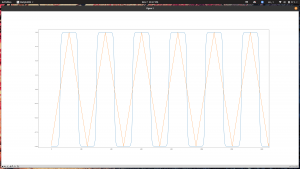Joe’s status update for 11/07
This week, I implemented and verified the software distortion effect. It uses entirely modular fixed point data types and is true to the hardware. In the picture below, the orange triangle wave is the input sound wave, and the blue curve is the output after applying the distortion effect.

Demos came up a bit fast on me, so I decided to start integration before implementing the low/high pass filters. I addressed all Git reviews from Eric and Manav for all of my work up until now, so nearly the entire audio layer (besides the filters) has been completed and merged with our master branch. I’ve started to piece together all of the modules and write a full testbench for the APU. The testbench has to simulate inputs from the event dispatcher, configuration settings, and global APU clock. Once I’ve finished the testbench, there should theoretically^TM be minimal effort needed to produce fully modulated audio, since each component has been thoroughly verified. I plan on finishing this by tomorrow, so that there is a demonstrable APU for the demo. I would be very happy with my progress if I can accomplish this, because it would mean we could demo something very close to what our final product would sound like.
After I finish integration of the APU in software, I will start to implement some of the hardware modules and come back to the filters later (or pass it off to Manav or Eric once they complete their modules). I will likely start with the floating point multiplier, adder, and power modules, then move to the wavetable oscillator since it’s the most important and might be the most difficult to port over to hardware since I need to figure out how RAM works on the FPGA. I don’t anticipate finishing all that by the end of the week, but hopefully I can get the wavetable oscillator written up at the very least.